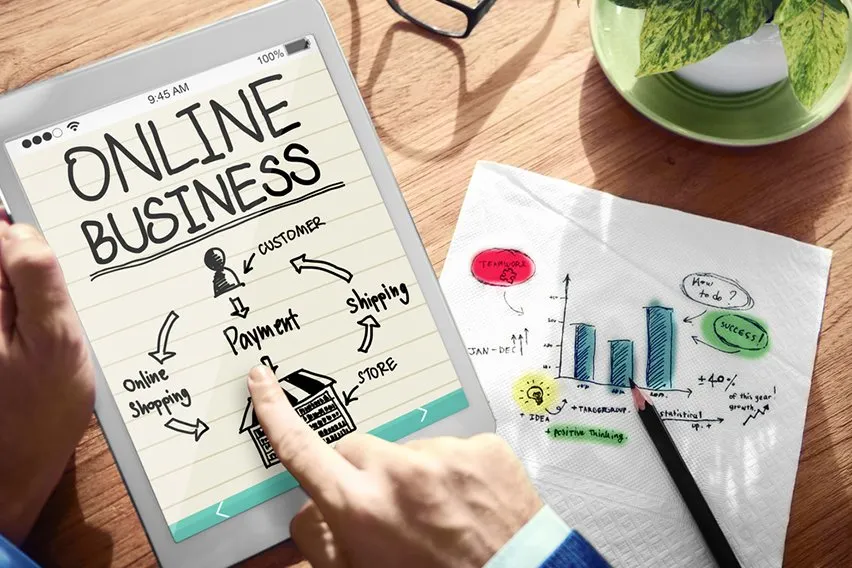13 Steps on How to Start a Business (2025)

Starting your own business can be an exciting and rewarding opportunity. With careful planning and the proper legal considerations, it can be a straightforward process. This is especially true if you have an entrepreneurial mindset, a positive attitude, persuasive communication skills, and self-motivation. You’ll also need the right information to set you up for success. In this article, we’ll discuss how to start a business in 13 steps.
Key Takeaways
- Your business idea should have unlimited earning potential.
- Competitor research helps you determine product viability.
- A business plan can help you acquire funding or partners.
- Your business structure has tax, legal, and liability implications.
- You’ll need a business bank account, EIN, registered business name, and business number.
- Use business tools to help streamline your processes and simplify tax time.
Table of Contents
- Determine Your Business Idea
- Research Competitors and Market Trends
- Build Your Business Plan
- Select Your Business Structure
- Register Your Business and Get Licenses
- Set Up a Business Account for Your Business
- Secure Funding for Your Venture
- Obtain a Business Credit Card
- Prepare for Tax Obligations
- Get Business Insurance
- Invest in the Right Business Tools
- Market Your Business
- Make Your Business Scalable
1. Determine Your Business Idea
To start your own business, you need to have an idea. Your idea creates the foundation for the business. The more you expand on the concept, the stronger your base is.
Your idea must have earning potential. It can be a one-time project, like developing an app or an invention you plan to sell. But in most cases, it should have unlimited earning potential and be something people will pay for.
Your business idea should be something you have some skill at or a strong interest in. One of the top markers of a successful entrepreneur is motivation and determination. Your business is unlikely to succeed if you lose interest or faith in your product.
Ask yourself if your business idea solves a problem. You are more likely to succeed if there’s a market gap that your business can fill. A diluted market drives down the value and increases your marketing overhead.
While you’re developing your idea, keep an open mind. Review and critique your idea often and ask for feedback from friends and trusted experts in the field.
A great business idea is the cornerstone of how to start a successful business. Take your time with this step and think it through carefully.

2. Research Competitors and Market Trends
A critical step in how to start a company is performing due diligence. Start with primary research by exploring the market. Connect with your potential market and perform interviews. Use social media or footwork to conduct surveys about consumer interest. Observe how the lack of your product impacts your market or how consumers use similar products. Utilize focus groups and contract research services, if applicable.
Move on to secondary research by collecting and analyzing existing data. Find and examine any competitors, including variations on your theme. Note their price point, marketing scheme, delivery methods, storefronts, and locations in your market area. Review all their iterations, versions, color options, size choices, flavors, and other options that might reflect their market research. Read their customer and peer reviews, where applicable.
Run a thorough SWOT analysis by exploring your strengths, weaknesses, opportunities, and threats. Use your primary and secondary research to support your results. This data can help you focus your idea and make the necessary adjustments before settling on a concept.
Complete a financial viability analysis to determine if you can produce the product in a way that allows for continuity and reasonable profit. Consider supply chain issues (shipping, flights, trains, etc.), resource trends (lumber, steel, gold), and common staffing issues. Many people assume it’s easy to find employees, but the reality can be different in many markets.
Perform a minimum viable product (MVP) test. This means you create a prototype or simplified version of your product and launch it to a select group of potential clients. Observe whether they find it valuable, how they use it, and whether or not it fills the market gap.
3. Build Your Business Plan
Writing a business plan is often the most overwhelming of the steps to starting a business. It is a key document used to attain financing, stakeholders, and partners. Even if you don’t want partners or need a loan, your business plan acts as a written foundation.
If you were thorough during steps 1 and 2, creating a business plan is easier than you think. In many cases, it’s as simple as filling in the blanks with the data you’ve already collected. Follow this outline for the key components of a business plan:
- Executive Summary: This is a short overview of the main aspects of your business. It’s meant to capture attention and interest in your project.
- Company Description: Use this section to describe your company. Give an overview of your vision and answer the five W’s—what, where, when, why, and how. You’ll have a chance to go into detail later. Keep it concise.
- Market Analysis: In this section, you’ll distill your market research into key points. Demonstrate that you’ve completed a thorough market analysis without going into too much detail about your process.
- Management and Organization: Outline your organization structure and business type. Include how and who will make decisions and an organizational chart if it’s relevant.
- Products and Services: List your products and or services in detail, including descriptions and pricing.
- Customer Segmentation: Divide your customer base into segments with shared characteristics or preferences.
- Marketing Plan: Include your marketing plan in detail. How to create a marketing plan is discussed later in this article.
- Logistics and Operations Plan: Add a section that discusses how you’ll achieve the end product.
- Financial Plan: Include a detailed financial plan. It’s likely to be the most scrutinized section if you’re applying for funding or seeking partners.
- Appendix: Include any other detailed information on the aspects you outlined earlier in the business plan, particularly about your logistics and market research.
4. Select Your Business Structure
Many small businesses start as sole proprietorships for the ease of establishment and financial benefits. Sole proprietorships don’t require legal consultation to establish, they’re easy to dismantle, have fewer upfront fees, and reporting taxes is as simple as completing a personal tax return. You also don’t need to share the profits.
The major drawback to a sole proprietorship is personal liability. Your business is not registered as a separate, legal entity, so you have no protection against lawsuits and tax implications.
Partnerships are a business structure type that’s suitable if you choose to work with one or more other people. Partnerships include general, limited, or limited liability partnership (LLP) structures. In a general partnership, all parties share the profits, debts, and liabilities. A limited partnership combines both structures in that one person takes on the liability while the other remains a silent partner. An LLP is common among doctors and lawyers who share a practice. Personal assets are siloed against liability in an LLP.
In a partnership, both parties can pool labor and resources. They can act as sounding boards for each other, helping to bring new ideas to life. However, with a partnership comes the opportunity for disagreement or mismanagement, additional debts or liabilities, and increased difficulty in selling or dissolving the business.
A corporation is a legal entity of its own. It separates the individual business owner, shareholders, and board members from any legal liability and business assets. Starting a corporation involves a significant amount of paperwork and ongoing annual filings.
It’s easier for an incorporated business to raise capital, sell shares, and divest ownership. While corporations can enjoy decreased tax rates, you are essentially taxed twice, first as a corporate entity on profits, then personally on your dividend income and capital gains.
Small businesses that start as sole proprietorships can always scale up to a partnership, corporation, or limited liability entity.
5. Register Your Business and Get Licenses
This step in starting a small business has a lot of variation. As a sole proprietor, you don’t need to register a business name if you do business under your own name. You also don’t need an employer identification number (EIN) if you don’t have employees, but it helps when it comes time to open a business bank account and pay taxes. Visit the IRS website to register for an EIN when and if you decide to hire employees.
You will need to register your business and apply for a license or permit depending on your state and the nature of your business. A state tax ID can also help protect sole proprietorships against identity theft. Visit your local municipal, state, or county website for more information.
To stand out as a business entity, it’s important to choose the right business name. Research other businesses with similar names to see if your name infringes on their registered identity. The US Small Business Administration (SBA) can help you determine if you need to register your name with the local, state, and federal government.
6. Set Up a Bank Account for Your Business
Setting up a business bank account can make managing your business finances much simpler. A business bank account can also help you remain legally compliant. It’s easier to attain a business credit card and merchant services with a business checking or savings account. You receive limited personal liability protection and better purchasing power.
Shop around for a bank with lower fees, introductory offers, and good benefits. When you’ve made your choice, you’ll need your social security number (SSN) or employer identification number (EIN), business license, ownership agreement, and proof of business address. If you are incorporated, you’ll need your articles of incorporation and proof of address for the named director.
7. Secure Funding for Your Venture
Acquiring funding is one of the most important steps in how to start a small business. This financial decision can affect your business structure and the operation of your business. Draw on the financial section of your business plan to determine how much funding you’ll need.
Self-funding through personal investments, mortgages, and family or personal loans can ensure you remain in control of the business. Speak to your mortgage advisor and financial planner about all the risks associated with leveraging your real estate assets or tapping into your retirement investments to fund a business venture. You take on all the risks with self-funding.
Venture capital from investors offers upfront financing for a share in the business and participation in the business decisions. It’s not a loan but an exchange for equity. It can also change your business structure.
Crowdfunding is another option that requires low risk for the reward. Crowdfunders donate or give money to your business in return for an acknowledgment rather than a share of your company.
A small business loan from a bank or professional lender is the perfect opportunity to pull out the business plan you worked so hard on. Be prepared to shop around for the best rates and terms for your loan. You’ll likely use the same bank or credit union for your business bank account and credit card.
You can also double your odds with a US SBA-guaranteed loan. Lender Match can pair you with a partner bank that offers SBA-guaranteed loans.
The US SBA also offers several investment programs, including the Small Business Investment Company (SBIC), the Small Business Innovation Research (SBIR) program, and the Small Business Technology Transfer (STTR) program. Each program offers funding to specific small businesses.
8. Obtain a Business Credit Card
A business credit card helps establish lines of credit with your suppliers and for large purchases required for product development. Getting a business credit card is difficult without an adequate credit history.
Some banks will put you on a probation period with a business-secured card that acts like a credit card but needs to carry a balance to make purchases. As you regularly make work-related purchases and payments to the card, the bank reports your history to various credit bureaus. It’s a good way to build credit history for your business when you are just starting out.
Credit card companies require the same information the bank asks for when you open your business account. And, just like with your bank and loan, you’ll want to shop around for a good rate, terms, and benefits.
9. Prepare for Tax Obligations
Small business owners operating general partnerships or sole proprietorships have the same tax responsibilities as regular taxpayers. You are responsible for filing your tax returns and paying your taxes owed on time—failure to do so results in penalties.
A corporation or LLC business structure will have additional obligations, including filing annual reports. However, corporations can file in calendar years or fiscal years.
Filing your taxes as a small business owner can be easy with the right support. You’ll want to get as much for each deduction as possible. Tracking your expenses, billable hours, and invoices is easier with expense-tracking software.
10. Get Business Insurance
Business insurance offers protection against unforeseen costs like natural disasters, lawsuits, death, and accidents.
Some types of business, loan, bank, and lease agreements require insurance. If you have employees, you are federally required to have Workers’ Compensation, Unemployment, and Disability Insurance. Other insurance requirements vary by state.
Common types of business insurance include:
- General Liability Insurance: Suitable for any business, general liability covers financial loss from settlements, judgments, bodily function loss, libel, slander, medical expenses, and property damage.
- Product Liability Insurance: This type of insurance protects businesses that manufacture, wholesale, distribute, or retail a product from financial loss resulting from a defective product.
- Professional Liability Insurance: Suitable for service businesses, this insurance protects against financial loss from malpractice, negligence, and errors.
- Commercial Property Insurance: This type of insurance protects businesses with property and physical assets from loss and damage resulting from weather, vandalism, and riots.
- Home-Based Business Insurance: This is a rider added to home insurance for business owners who operate out of their homes.
- Business Owner’s Policy: This policy suits all small business owners and combines other typical coverages into one convenient, low-cost option.
Not all business owner’s policies cover everything. Your business location can also influence your coverage and rates. Carefully read your proposed policy and discuss the details with your provider before purchasing.
11. Invest in the Right Business Tools
Investing in business tools can streamline your small business administration and processes, leaving you more time to focus on aspects of your life you can’t automate, like self-care.
Accounting Software
Accounting software can help streamline your financial processes. FreshBooks accounting software is cloud-based for your convenience. It offers industry-standard double-entry accounting, invoicing, bookkeeping features, and expense tracking.
Project Management Software
Utilize project management software to create professional documents, RFPs, SOWs, and project plans. FreshBooks project management software includes templates, collaboration tools, and web-based centralized file storage.
Payment Processor
Payment processors allow you to take online and in-person payments for invoices and services. FreshBooks Payments can do all that and more, integrating with multiple payment providers and making it easier for clients to pay for your products or services. Send invoices directly from the FreshBooks app or your online account. Invoices contain links and one-click payment options to streamline the process for your clients.
CRM Software
Client/Customer Relationship Management (CRM) software combines all your client data into one cloud-based location. FreshBooks software offers multiple CRM integration partners to make collaboration and customer management easy.
Scheduling Software
Scheduling software can save time and streamline your small business administration. You can manage shifts, clock in and out, assign salaries and permission, and more. FreshBooks integrates with several top-rated scheduling products to help simplify your business processes.
Inventory Software
Inventory software helps you to track incoming and outgoing inventory, identify weaknesses in production, and streamline production efficiency.
12. Market Your Business
In this digital age, there are more ways of marketing your new business than ever before. Start by developing your brand package. It can be as simple as selecting a font and colors for your business name. Your brand will be the most recognized feature of your online presence. It’s worth taking the time to consult a professional to develop a brand package. Professionally developed brand packages should include original logos in digital and print-ready format.
When it comes to an online presence, at a minimum, you should have a Facebook page or website. These platforms allow you to inform people about your services, hours of operation, and contact information. Facebook offers step-by-step instructions on how to set up your page and best practices to maximize the platform.
When creating a website, you get what you pay for. Some companies offer free websites but charge you to unlock features like using your own domain name and adding payment options.
You can also use social media platforms like Instagram and TikTok to put your brand in front of prospective buyers. Paid social media advertising can ensure customers in your preferred demographic see your product by utilizing data mining and algorithms.
Advanced online marketing techniques use search engine optimization (SEO) techniques. These methods use keyword and phrase strategies to boost your position in browser searches.
Analog marketing includes talking about your product at service groups, church functions, and other public speaking opportunities. Print advertising in specialized or location-specific magazines can provide long-term visual exposure, depending on the display location.
13. Make Your Business Scalable
A common mistake small businesses make is failing to plan for success. Breaks in production or delays in promised services can cause the consumer to move on to other options. Design your new business so that you can expand production, add partners to help manage workload, or develop collaborative relationships with other creators that give you options when you need to pivot.
Your upscale plan should include tools that help your growing small business administration needs.
Introducing your products in phases is another way to scale your business, rather than rushing all your products to market at once.
You can also expand your marketing plan in phases to allow you to reach broader markets as your brand gains recognition.
How To Start a Business With No Money
Starting your own new business can seem like a fantasy when finances are tight or in a deficit. But before you give up hope, know there are ways to do it.
The first recommendation is to keep your current job. It provides you with an income while you get your business plan together. Another step is evaluating your financial needs and what it will take to make your entrepreneurial dreams come true. For example, you might need to take out a small business loan.
Don’t forget the power of experience. Talk to someone who’s succeeded in small business ownership, knows about money lending and leveraging capital, or has experience in the field of business you want to get into, or all three.
Finally, get out into the community and meet people. Networking with the right people can open doors you may not know about.
You can learn more in our article on How to Start a Business with No Money. It outlines the steps to starting your own business and explores which businesses are the cheapest to start.

Launch Your Business Dreams
Small business ownership can put you in control of your destiny. With careful planning and the proper support, starting a small business can be an exciting and rewarding endeavor. Follow the steps outlined in this article to begin your entrepreneurial journey.
Set yourself up for success by utilizing tools designed for small businesses. FreshBooks business suite of software tools offers features, integrations, and solutions for small business owners.
Reviewed by
Sandra Habiger is a Chartered Professional Accountant with a Bachelor’s Degree in Business Administration from the University of Washington. Sandra’s areas of focus include advising real estate agents, brokers, and investors. She supports small businesses in growing to their first six figures and beyond. Alongside her accounting practice, Sandra is a Money and Life Coach for women in business.
RELATED ARTICLES


 How Much Does It Cost to Start an Online Business in 2025
How Much Does It Cost to Start an Online Business in 2025 How to Use Social Media to Make Money: 4 Ways
How to Use Social Media to Make Money: 4 Ways How Much Does It Cost to Build a Warehouse?
How Much Does It Cost to Build a Warehouse? 5 Steps for Successfully Starting a Construction Company
5 Steps for Successfully Starting a Construction Company 5 Questions to Ask When Buying a Business
5 Questions to Ask When Buying a Business How Much Does It Cost to Open a Bar?
How Much Does It Cost to Open a Bar?